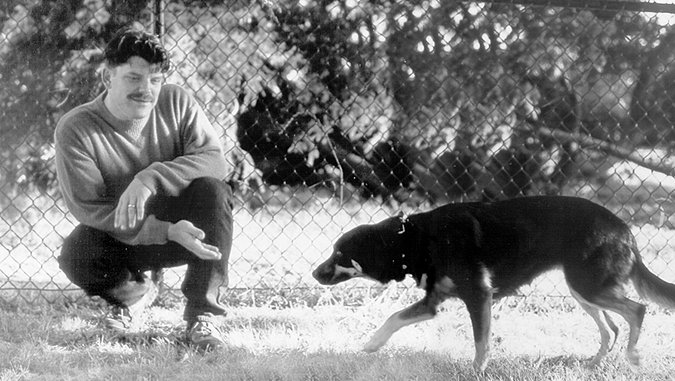APPEASEMENT SIGNALS OVERVIEW
What you can do…
– Take time to observe both your dog and other dogs. Start noticing in greater detail the body language signals they use to communicate with you, other dogs, and other humans.
– Watch videos and DVDs on dog body language – nice because you can back up and watch a segment repeatedly to fully analyze the behavior – and then look for similar behaviors in the dogs you observe.
– Look especially for appeasement and deference behaviors and train yourself to respond appropriately when they are offered.
Katie, our cranky, creaky, geriatric Australian Kelpie, is grumpy with just about every other member of the canine species. I was at least a little concerned when we brought home our most recent family member, Bonnie, a Scottie/Corgi/Whatever-mix.
At age five months, Bonnie came with a personality that was one of the softest and sweetest I’ve seen in ages. In fact, I suspect she was surrendered to the shelter by her owner of just one week in large part due to the fact that she urinated submissively the instant anyone spoke to or touched her. I worried that Katie’s gruff admonitions would be too much for her sensitive nature.
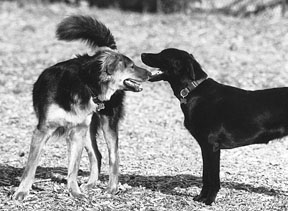
Quite to the contrary, Bonnie’s willingness to defer to Katie with obviously submissive body language at every turn has averted any potential conflict. In fact, Bonnie gets along with Katie – and the rest of our pack – better than any of our other dogs simply because she’s so appeasing. I was surprised and immensely delighted when I looked out my office window one day last week to see Bonnie and Katie playing, no, romping together in the backyard!
Reading Dogs’ Signals
Paradigm shifts in the dog-training world in the last decade have led dog owners and trainers to pay closer attention to the observation, interpretation, and understanding of canine body language. Norwegian dog trainer Turid Rugaas identified more than 30 body gestures that dogs make in social settings – whether with members of their own species or with humans – that, she postulated, demonstrated an intent to get along with other “pack members.” Rugaas coined the term “calming signals” to collectively describe these gestures and their purpose, and the term has found acceptance and everyday use as dog owners and trainers discuss dog behavior. Clumped behind that deceptively simple phrase, however, is a complex constellation of behaviors that accomplish many more purposes than just “calming.”
Rugaas has asserted that dogs purposely use “calming signals” to calm the other being with whom the dog is interacting. The suggestion is that the behaviors brought under this broad umbrella are deliberate.
Today, many ethologists (people who study animal behavior) speculate that the communications now popularly identified as calming signals are often hardwired, automatic responses rather than deliberate ones, and are far more complicated than a simple attempt to calm a dog’s social partners. They likely have more to do with the presenter’s own state of mind and/or an end goal to affect the behavior of the other dog or human for the purpose of self-preservation – rather than a deliberate intent to change the state of mind of the other being.
Communicative behaviors are adaptive in nature, helping canids maintain peaceful pack relationships without resorting to violence. Ethologists suggest that nonthreatening canine behaviors are more important in keeping the peace in packs than dominance behaviors – that relations are primarily maintained by deference behaviors exhibited by subordinates toward high-ranking members, not dominance displays by the alpha member. Canine social groups may more appropriately be described as deference hierarchies rather than dominance hierarchies.
As such, the dozens of behaviors that have been dubbed calming signals might more appropriately be separated into several subgroups called appeasement (active submission), deference (passive submission), displacement, stress signs, and threat (dominance) displays.
By observing dogs, learning to recognize and respond to the various behaviors in this constellation, your relationships with canines will become richer, and your translations of dogspeak more accurate. Let’s start by taking a closer look at the submissive/subordinate behaviors. We’ll examine other classes of behaviors in future articles.
Understanding Appeasement in Dogs
As stated above, subordinate behaviors can be grouped into two general categories: active submission (appeasement), characterized by increased activity and diminished posture, and passive submission (deference), denoted by decreased activity and lowered body posture. The difference lies in whether the dog offering the submissive behavior desires attention from the higher-ranking individual, or would prefer that the attention he’s receiving go away.
Active submission may also be identified as attention-seeking behavior: nuzzling, licking (including licking ears and lips), jumping up, paw lifts and pawing motions, “smiling,” teeth clacking, crouching, pretzeling, and play-bows. The dog’s ears may be pulled back, and his tail may be wagging expressively, with wide, sweeping movements or circles. These behaviors can often be seen during greetings between dog and owner, or between friendly, compatible dogs.
Passive submission usually involves a dramatic reduction in activity with a goal of diverting attention, and is most often seen in a lower-ranking dog when threats are directed toward him by a higher-ranking member of the social group (dog or human). The dog’s ears may be pressed flat against the head, with his tail tucked between legs. The subordinate dog often freezes, averting eye contact, lowering his head and body, sometimes to the point of going “belly-up” on the ground. Passive submission may also be accompanied by submissive urination.
Below are descriptions of several common submissive behaviors, and suggestions for appropriate responses when the behavior is directed toward humans. When directed toward dogs, submissive behaviors usually elicit appropriate responses from the other canine. In the future, I’ll describe one instance in which submissive behaviors don’t elicit appropriate responses from the other dog: when the other dog responds with increased intimidation – a classic “playground bully.” Dogs who respond to an overt display of submission with increased aggression are not displaying normal canine behavior, and may need special management to prevent them from traumatizing their social partners.
Active submission (appeasement)
Some of the gestures exhibited by a dog who is demonstrating active submission can be obnoxious to us humans. The important thing to recognize is that, with these behaviors, the dog is communicating his recognition that you are his leader, a higher-ranked individual. Be a good leader and let him know how he can best appease you by redirecting his behavior into something less bothersome.
• Nuzzling – Dog pushes muzzle against you, perhaps under your arm or hand. If you respond by giving the dog attention (petting, making eye contact, speaking to him) you are positively reinforcing the behavior and it will continue or increase. This is fine if you like the behavior – and some people do. It can, however, become annoying if the dog is very persistent.
You may prefer to extinguish the behavior using “negative punishment.” When the dog nuzzles you, turn away or even walk away. The dog is seeking attention. If nuzzling consistently evokes the opposite of the intended response – attention goes away – the behavior will stop. Of course, you must educate all family members and visitors to respond to nuzzling in the same way, or the behavior will be randomly reinforced and will persist.
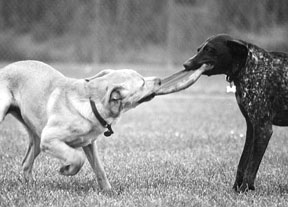
Another option is to put the behavior on cue, and teach the dog that nudging only works to elicit attention when you ask for it. You can also preempt the nuzzle by consistently asking the dog for an incompatible behavior that gains him the attention he seeks. A “sit” or “down” can serve as incompatible and polite attention-seeking behaviors if you consistently give your dog attention for those.
• Licking – Dog licks body parts and clothes, including lip-licking, ear-licking, and nose-licking. Again, if you like this behavior, you can encourage it with positive reinforcement – giving your dog the attention he seeks when he licks.
If you don’t enjoy your dog’s licking, use negative punishment (licking makes you go away) and install an incompatible behavior in its place. Having your dog hold a toy in mouth when he approaches people is a great attention-eliciting behavior that’s incompatible with licking.
• Jumping up – Dog puts paws on human body, often projecting body against human with some force. A lot of small-dog owners don’t seem to object to jumping up as an attention-getter, and a lot of small dogs are incorrigible jump-uppers as a result. Not all people with small dogs like this, however, and most people who live with medium-to-large dogs much prefer four-on-the-floor.
Jumping as an attention-getting behavior is positively reinforced by attention, even behavior that dog owners may offer to try to reduce jumping up, such as pushing the dog away, or telling him to get down. Once again, removing yourself from contact with the dog – taking the attention away – will reduce the behavior, especially if you replace it by reinforcing an incompatible behavior such as sit or down. See the pattern yet?
• Paw lifts and pawing motions – Dog lifts paw or paws at human. While uncontrolled pawing behavior can be annoying, a simple paw lift is a lovely behavior to put on cue and turn into a series of fun and useful behaviors. A paw lift on cue can become “shake,” “wave,” “high five,” and “salute,” and pawing motions can be useful for turning appliances on and off, indicating found objects for dogs doing scent and search work, pushing a ball (canine soccer!), and playing an electronic keyboard. Persistent, annoying pawing is best extinguished by ignoring the behavior and putting an incompatible behavior on cue, such as four-on-the- floor, or a gentle paw lift.
• Teeth clacking – Dog’s teeth click or chatter. This is an innocuous behavior, and one that you can simply ignore – unless you’re an avid trainer and want to encourage it by clicking and treating when the dog offers it, then putting it on cue.
• Crouching – Dog lowers his body closer to the ground. This is also an innocuous attention-seeking behavior. If it bothers you, ignore it, and reinforce your dog when he approaches you standing taller. Training, using positive methods, will also increase your dog’s confidence and decrease incidents where he feels compelled to make himself smaller.
• Pretzeling – Dog corkscrews his body into a “C” shape. This is also a harmless, kind of cute behavior that I’d be tempted to reinforce and put on cue!
• Play bow – Dog lowers his forequarters while keeping his hindquarters elevated. This is a lovely behavior, and I can’t imagine someone wanting to extinguish it. I’d reinforce and put it on cue.
• Smiling – Dog lifts his lips into a grimace that is unaccompanied by other behaviors that would indicate at threat. I see no reason to try to make this behavior go away as long as humans around the dog understand that it’s not an aggressive behavior. I think it’s quite cute! I’d encourage it by clicking and treating when the dog offers a smile, and then put it on cue!
Passive submission (deference)
Deference behaviors are offered by the dog in response to a perceived threat – there doesn’t have to be any intent to threaten on the part of the person interacting with the dog. For all of the deference behaviors listed below, the appropriate response is to determine how/why the dog perceives a human or humans as threatening, and then work to change the dog’s perception through consistent positive associations with the perceived threat(s).
Human behaviors that can be perceived as threatening by a dog (thereby eliciting deference behaviors) include direct eye contact, a full-frontal approach, a loud voice, bending over the dog, and patting him on top of the head.
Punishing or “correcting” a dog for offering a deference behavior is the worst thing you can do if you hope to modify the behavior. He will only intensify his deference in a futile attempt to convince you he’s being subordinate. In a worst-case scenario, he may even become defensively aggressive if his deference signals aren’t working.
Instead, ignore the behaviors when they happen, and work to build your dog’s confidence in relationships by being consistently nonthreatening and insisting others do the same. You can also build confidence through positive training; when the dog has a better understanding of how to influence and predict his environment, his confidence will increase.
A dog’s deference behaviors may include any or all of the following:
• Tail tucked – Dog pulls his tail tightly against his belly to cover and protect his vulnerable underparts. Even dogs with “gay” tails or tails that curl over their backs can do this when sufficiently threatened.
• Freeze – Dog ceases all motion as he attempts to convey his submission to the party threatening him – usually in conjunction with averting eyes.
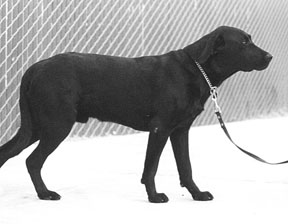
• Averting eye contact – Dog shifts eyes to avoid making eye contact, or actually turns head away.
• Lowering head and body – Dog ducks head and/or crouches closer to the ground.
• “Belly-up” – Dog rolls over on back and exposes vulnerable underparts. (Can also be a simple invitation for a tummy rub when not accompanied by other deference behaviors.)
• Submissive urination – Dog urinates in response to perceived threat (not necessarily an actual threat) in a person’s voice, touch or approach.
Major Misunderstandings Between Primates and Canines
Humans have long misunderstood their dogs’ submissive behaviors and reacted inappropriately as a result. In many human cultures, failure to make eye contact is a sign of someone who is untruthful, shifty, and sneaky. Similarly, dogs who display submissive behaviors such as averting eyes and lowering body posture (“slinking”) are often perceived as wimpy, cowardly, sneaky, manipulative, guilty, and disobedient – misinterpretations based on our familiarity with primate body language.
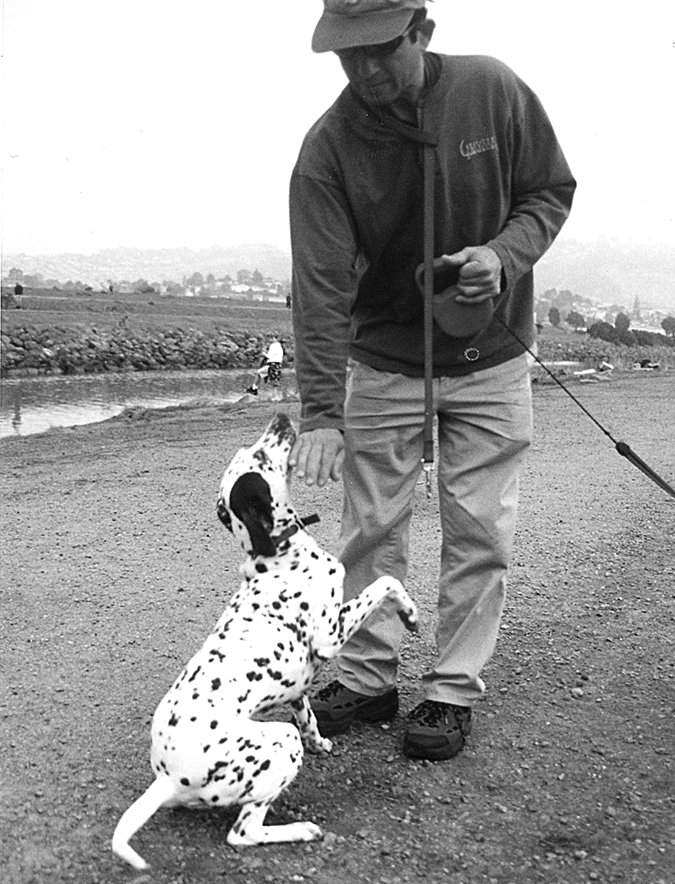
Unless wise to the ways of canid communication, humans tend to assume a dog offering lowered body-posture deference behaviors is expressing guilt, when in fact he’s only responding to a perceived threat in his human’s body language.
Sometimes the more the dog acts guilty, the more righteously angry his human gets, the more submissive (guiltier) the dog acts – a lose/lose cycle if there ever was one.
Submissive urination is another case in point. Owners who still employ the old-fashioned punishment dog-training paradigm may attempt to physically or verbally “correct” a pup for urinating submissively — the exact wrong thing to do.
A pup urinates submissively in response to a perceived threat, such as the assertive approach of a higher-ranking member of the social group. In the dog pack, this is a useful survival mechanism that effectively averts the wrath of most adult dogs, who could otherwise do serious harm to a young subordinate.
Unfortunately, when the higher-ranking member is a human, the behavior (urination) that should avert wrath often initiates or escalates anger in the human. The pup’s response is to urinate more – not less. The human gets angrier, the pup pees more, the human gets even angrier, the pup pees even more in a desperate attempt to turn off the anger – and another lose-lose cycle is born.
Even the submissive grin is misunderstood. Sadly, it can be mistaken for a snarl, and a dog who is actually anything but may be labeled as aggressive. It’s also often perceived as a doggy version of a happy smile — a less-damaging interpretation, but still a misinterpretation of a clearly subordinate display.
Interestingly, the submissive grin is believed to be an imitation of the human smile, since dogs don’t normally display this behavior to each other, only to humans.
While some behaviorists consider the grin to be an attention-seeking appeasement gesture, others consider it more of a threat-averting deference signal. In any case, it’s important to understand that the dog who grins is making a status statement (your rank is higher than his), and is exhibiting neither an aggressive threat nor a relaxed, contented smile.
More to Come
It’s been a joy to watch Bonnie develop over the past months. Training and a consistent lack of threats or intimidation in her relationship with us and the other humans in her life have increased her confidence. While she still offers appropriate appeasement and deference behaviors to Katie and the other canine members of our pack, her submissive urination with humans has ceased and her confidence and comfort with us has increased exponentially. It’s been weeks since a pat on the head resulted in a puddle on the floor!
In future articles, I’ll describe the other canine behaviors that have been (inaccurately, I think) called “calming signals” – what I would label as displacement, stress signs, and threat (dominance) displays.
Pat Miller, CBCC-KA, CPDT-KA, is WDJ’s Training Editor. Miller lives in Fairplay, Maryland, site of her Peaceable Paws training center.


